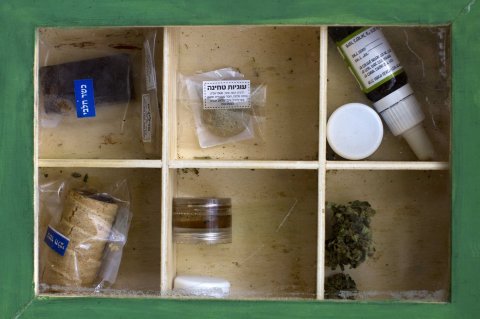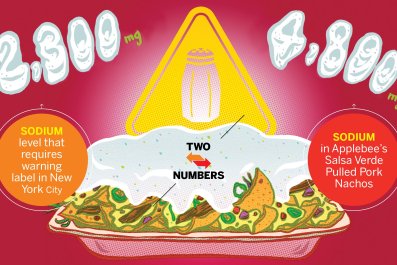In 1964, Raphael Mechoulam rode a public bus from Tel Aviv back to his lab at Israel's Weizmann Institute of Science in Rehovot while holding 11 pounds of Lebanese hashish in a plastic bag. He received his giant stash—the first of many over the next 50 years—from a police officer who had confiscated it from smugglers. "Advantages of living in a small country," the chemist, now 85, says with a mischievous smirk.
That hashish turned out to be a gift to science and modern medicine. A few months later, Mechoulam used it to, for the first time in history, isolate, elucidate the structure of and fully synthesize tetrahydrocannabinol (THC), the psychoactive ingredient in cannabis. Scientists knew that marijuana got you high but had struggled for decades to figure out exactly how. Mechoulam and his colleagues were also the first to decode the exact structure of cannabidiol (CBD), the primary nonpsychoactive component of marijuana, and the first to test the medicinal properties of THC. Today, thousands of children around the world receive THC drops to cope with cancer and epilepsy.
"While morphine had been isolated from opium 150 years previously, and cocaine had been isolated 100 years previously, the chemistry of cannabis was unknown," says Mechoulam. To determine the psychoactive ingredient in marijuana, Mechoulam became his own test subject. To begin, he and his team identified several compounds in the plant, including THC and CBD, and injected them into monkeys. THC was the only compound that elicited a reaction from the monkeys, most often drowsiness. "A few months later, we tested it on humans, on ourselves," says Mechoulam. "We had a group of 10 friends, including my wife and I. Half of us took THC, sprinkled on a piece of cake, and half took the piece of cake without anything else." Everyone who ate the THC-laced desserts had some type of reaction. Bingo.
Mechoulam got a normal slice of cake, but his wife's was covered in THC. "My wife just sat there, relaxing, kind of in another world," recalls Mechoulam. "Another fellow didn't stop talking for an hour or two. And one of them said he didn't feel anything, but every minute he would start laughing his head off."
Mechoulam, a child of the Holocaust who was born in Bulgaria in 1930 and emigrated to Israel in 1949, had originally planned to spend just six months researching cannabis. Today, he's still at it and is one of the most widely published authorities on one of the world's most popular plants. His work has transformed the Holy Land into the birthplace of not only Judaism and Christianity but also the modern medical marijuana industry.
In 1992, Mechoulam and his team at Jerusalem's Hebrew University made another groundbreaking discovery. Nearly 30 years after discovering that THC was responsible for the marijuana high, scientists still didn't know exactly how the plant made the human mind and body react that way. Mechoulam and his team found the answer: THC triggered what they called the endocannabinoid system, which they figured out was the largest receptor system in the human body. Mechoulam's team also determined that the human brain produces its own cannabinoids—two compounds that stimulate this receptor system almost exactly as THC does. They named one molecule 2AG and the other "anandamide," after the Sanskrit word ananda, which means "bliss." Mechoulam and other influential researchers believe that these compounds could alleviate dozens of diseases and ailments, including schizophrenia, diabetes, cancer, eating disorders, brain injuries and neurodegenerative diseases, such as Parkinson's, Alzheimer's and multiple sclerosis. However, scientists have not yet been able to secure the funding they need to satisfy the conditions (typically set forth by each country's health regulator) required to test the chemical on humans.
Nevertheless, the discovery of this endogenous cannabinoid system has revolutionized weed science. "We wouldn't have the scientific interest we have now around the world without the discovery," says Paul Armentano, deputy director of the National Organization for the Reform of Marijuana Laws, an American nonprofit. "That really opened the door to making the study of cannabis and cannabinoids a legitimate avenue." Since 1992, says Mechoulam, the formerly skeptical attitude of the medical community toward cannabis has changed completely. His research on anandamide, for example, has been cited in respected scientific journals some 4,000 times. In fact, a recent study conducted by the U.S. National Institutes of Health (NIH) found that the endocannabinoid system is involved in essentially every human disease. Indeed, the fact that medical marijuana is legal in dozens of U.S. states is a result of this discovery.

Still, Israel is one of just three nations in the world with a government-sponsored cannabis program, joined by Canada and the Netherlands. There is even a Medical Cannabis Unit within the Israeli Ministry of Health. Eight private companies are permitted by the government to produce and distribute the drug to the country's 25,000 licensed medical marijuana patients. Cannabis can be prescribed for many conditions, including cancer, chronic pain, post-traumatic stress disorder, arthritis, pediatric epilepsy and Crohn's disease. Patients can get their medicine in the form of cigarettes, baked goods, balms, liquid drops and buds, which they can roll into cigarettes or smoke out of a pipe or vaporizer. They can obtain and use cannabis at state-run hospitals and private clinics or have it delivered to their home.
Israel has also become the United States's unofficial offshore medical marijuana research center. Despite the fact that the U.S. has a $3 billion—and growing—medical marijuana industry, the government continues to block scientific study of the drug. In the U.S., medical marijuana is legal in 23 states and Washington, D.C., but the Drug Enforcement Administration still labels it as a Schedule I narcotic, "with no currently accepted medical use and a high potential for abuse." That's the same classification as heroin and supposedly makes it more dangerous than cocaine and methamphetamine, Schedule II drugs. This policy makes conducting research into the medical benefits of marijuana in the U.S. notoriously difficult. Those who wish to do so must go through the FDA, DEA and the National Institute on Drug Abuse. Even when American researchers are given approval for federally funded research, they have only one source: a farm at the University of Mississippi, operated by NIDA.
That's why American companies are turning to Israeli researchers and organizations. Mechoulam, for example, works with three U.S. companies developing cannabinoid drugs. One of them is Kalytera, a California-based company for which he serves as the head of research. Even the U.S. government relies on Israel for its medical marijuana exploration. The NIH, which rarely provides overseas grants, has been funding Mechoulam's research for 50 years. It started in 1963, when Mechoulam applied for NIH funding and was told that cannabis research wasn't of interest to the agency because marijuana wasn't an "American problem," recalls Mechoulam. "They told me to let them know when I have something more relevant to the U.S." A year later, Mechoulam received another call from the same official. A U.S. senator, whose name the official withheld from Mechoulam, had caught his son smoking weed. The senator had asked the NIH what effect the drug might have on his son's brain. To the embarrassment of America's top public health agency, no one could answer the question; there was no research on file. The NIH official asked Mechoulam if he was still working on cannabis. For the next 45 years, the NIH gave Mechoulam's team approximately $100,000 per year to study, for example, how cannabinoids can lower human resistance to antibiotics.
Meanwhile, Cannabics, a Maryland-based company that conducts all of its R&D in Israel, is using the Middle Eastern country as a testing ground for the world's first large-scale clinical trial of cannabis to treat cancer patients. Medical marijuana is already widely used to manage the pain and nausea that come as side effects to chemo and radiation therapy, but many medical scientists believe there are compounds in the marijuana plant that could kill cancer itself. Eyal Ballan, the Israeli co-founder and chief scientist at Cannabics, established the company in the U.S. because it represents an exponentially larger market than will ever be found among Israel's 8 million residents. He chose to keep all of the company's research and clinical trials in Israel, though, because "it's essentially impossible to do it in the U.S.," he says. "The doctors, scientists and the government are much more open-minded [in Israel]."
Leaders in the American medical marijuana community hope the U.S. will learn something from Israel. "Marijuana was an integral part of American medicine for more than 100 years, from the 1830s through the 1940s, and it was used safely and effectively for all of that time," says Dr. Alan Shackelford, a Harvard-trained physician who prescribes medical marijuana in Colorado. But today, bipartisan legislation (the Compassionate Access, Research Expansion and Respect States Act) meant to reclassify marijuana as a Schedule II drug remains stalled in Congress, "not for any scientific reason but pretty much out of ignorance of what is actually intended, which is to allow scientific inquiry and study," Shackelford says.
Having seen the clear medical benefits of cannabis over more than 50 years of research, Mechoulam is baffled that there's still reluctance to embrace marijuana as medicine. "We believe modern science is going ahead, right?" he asks. "Well, it's not. When insulin was discovered in the 1920s, it became a drug in months. Cortisone was discovered in the late 1940s, and it was made into a drug a year or two later. Anandamide was discovered 23 years ago and has still never been administered to a human being. I'm not sure that's progress."
Correction: A previous version of this article incorrectly stated that Mechoulam still receives NIH funding. He received NIH funding from 1964 until 2010, when he stopped applying for the typically three-year grants.






















